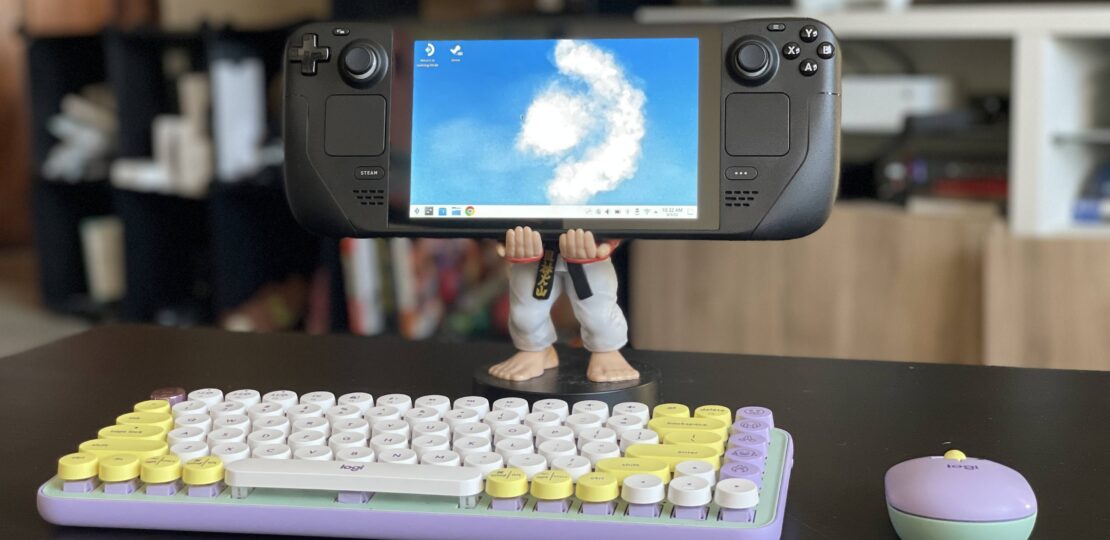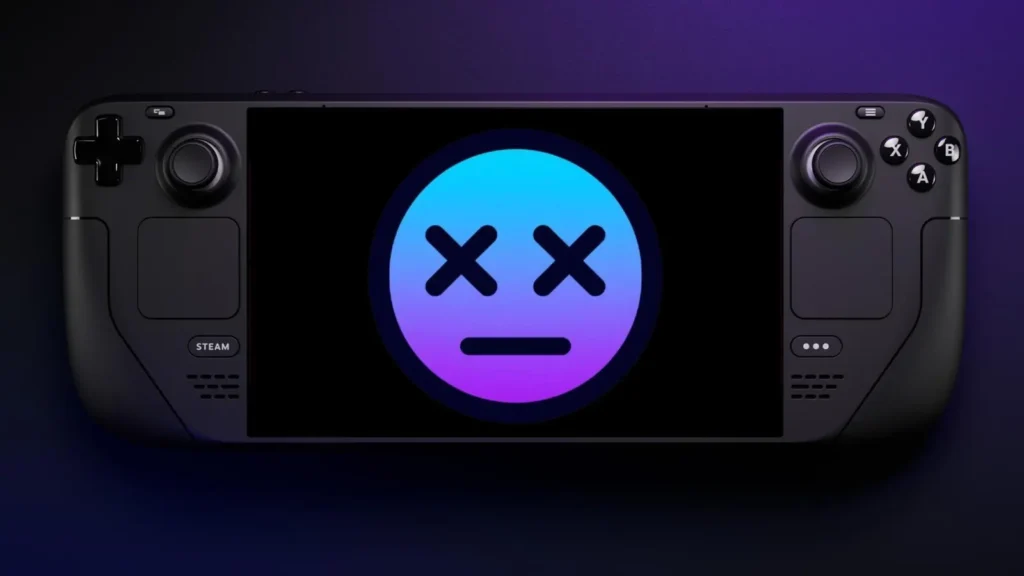
The Steam Deck is built with solid metal, double insulation, and weighs 18 ounces. It comes in both light and dark modes. Normally, I’m a dark mode kind of person, but I’ve actually found myself using light mode a bit more with this device. Just an observation. I’ll leave the choice of mode to you, though. I’ll be keeping an eye on which one sells better. Choose wisely—and don’t forget to stay hydrated! But anyway, here it is—the Valve Steam Deck.

We’ve been teasing it for a while now, and there’s a lot of buzz around it. After using it for some time, I can see there are only a certain type of people I would recommend it to. But for those who are into it, they’re going to have a ton of fun.
At its core, the Steam Deck is a $399 handheld gaming console with a screen and non-removable controls, packed with the power of a mini PC. If you haven’t heard of it before, it’s a bit tricky to explain. A lot of people might think, “Oh, it’s like a Nintendo Switch, but better.” But in reality, it’s much more than that.
Valve isn’t exactly known for its hardware, though. We all know about Steam, and they’ve made some great games, but they haven’t had the best track record with hardware. The Steam Controller was discontinued, and the Steam Link didn’t really last either. Don’t even get me started on Steam Machines. It’s unclear how long the Steam Deck will last, but I’m hoping it sticks around.
The real challenge for the Steam Deck is this: it’s meant to play any game in your Steam library wherever you are, which is an amazing idea. The problem, though, is that most games are designed with different control schemes in mind. Some are made for mouse and keyboard, others for a controller, some need just a keyboard, and some are a mix of everything. The Steam Deck is trying to handle all of that, adapting to different game controls as best as it can.
I’m not sure what type of gamer you are, but for me, I tend to get really into one or two games at a time. I’ll play them non-stop until I get burned out, and then I’ll move on to something else. Other people, though, tend to have a bunch of games they’re rotating. Regardless of how you play, though, I don’t think you’ll be able to get the same level of performance on the Steam Deck as you would on a PC. But honestly, that’s not a big deal for me, because the fun of being able to play games anywhere I want totally makes up for it.
When it comes to ergonomics, I think the Steam Deck does a really good job. It’s definitely bigger than a Switch, but it’s still surprisingly light, weighing in at 688 grams—about one and a half times the weight of the Switch. The whole thing is made of plastic, but it doesn’t feel cheap at all. There’s no creaking or flexing, and it feels really well-built.
The controls are packed in. On the front, there’s a 7-inch touchscreen with a 1280×800 resolution and a 60Hz IPS display. You’ve got the standard A, B, X, Y buttons, a D-pad, and two thumbsticks that have a nice texture to them. Plus, there are two touchpads with haptic feedback. On the top left, there’s a View button, and the Menu button is on the top right. The Steam button on the bottom left brings up the Steam menu, while the Quick Settings button on the bottom right lets you adjust things like battery life, frame rate, and brightness.
On top, you’ve got the four shoulder buttons—R1, R2, L1, and L2—and on the back, there are four extra grip buttons that can be customized: R4, R5, L4, and L5. The layout is great, and the back buttons sit comfortably where your fingers naturally rest. The grip is well-shaped and feels natural to hold.
The speakers are front-facing, and up top, you’ll find the volume buttons, a headphone jack, and a USB-C port for charging. At the bottom, there’s a microSD card slot, which is a pretty important feature for expanding storage.
The $399 model is the base version, and it comes with 64 GB of storage, which is the smallest and slowest option. If you take a quick look at your Steam library, there’s a good chance you’ll find at least one game that’s larger than 64 GB.
I’ve got the 256 GB version, which costs $529. There’s also a 1TB model coming soon for $649, and it will have a nano-etched display. Right now, I only have two games installed: “Dirt Rally” (about 40 GB) and “NBA 2K22” (117 GB), so my storage space is pretty tight.
Luckily, there’s a microSD card slot, so you can add more storage easily. You can pop in a 1TB card, and performance stays solid when you play games off of it. I’d definitely recommend grabbing one to save some money and increase your storage.
Once I got my hands on the Steam Deck, all I really wanted to do was play games. I immediately started playing those two games in places I never thought I would. Normally, I’d be stuck in the same room with my gaming PC, but now I was playing “Dirt Rally” on the couch, or in other random rooms around the house. It’s pretty liberating to be able to game wherever you are—whether it’s in the back of a car, on a plane, or even waiting at the doctor’s office.
Honestly, you can game pretty much anywhere you’ve got a free hour or two. There is a bit of latency, but it’s something you get used to after a while. Sure, you’re not going to perform as well as you would on a high-end gaming PC, but it’s still a fun experience.
And that’s the thing: if you get too caught up in the specs, you might miss the point. The Steam Deck has a custom AMD APU and 16 GB of RAM. Sure, you might wish for a 90 Hz or 120 Hz display, or faster storage to reduce latency a bit, but in the end, it still offers a solid and enjoyable gaming experience.
The battery life is something to keep in mind—it’s rated between two and eight hours, but honestly, you’ll probably be closer to the two-hour side of that range most of the time.
The 60 Hz refresh rate and the 1280×800 resolution on the 7-inch screen are totally fine. The controllers feel great too, really comfy to use. For example, I play a lot of “NBA 2K,” and it works perfectly well on the Steam Deck.
There is a slight delay between moving the controls and seeing your player respond, even when you’re not playing online. It’s most noticeable during free throws or any action that requires precise timing. It takes a little time to adjust, but once you get the hang of it, it’s a lot of fun. I’ve always played “NBA 2K” on my couch with the PlayStation or on a gaming PC, but now I can play it pretty much anywhere. It’s wild to be able to play “2K” on a plane or in a random spot away from my usual setup—it feels like unlocking a whole new level of fun.

The real plus here is that the games I’ve been playing work so well on the Steam Deck because their controls are already mapped for controllers. I mean, you could use a wheel for “Dirt,” but these games are designed for controllers, and they translate perfectly. But if you try using the touchscreen or touchpads to navigate in “2K,” it’s a mess. The mapping is really inconsistent and doesn’t work well at all. That’s why these games are listed in the “Great on Deck” section of the Steam Store—they’re games where the controls are mapped perfectly.
The downside is there are plenty of games that just don’t work well on the Steam Deck or haven’t been tested enough. There are even some games in the Steam Store that are completely unsupported and won’t work at all. If you want to avoid frustration, you can filter your search to show only verified games. Or, if you’re feeling adventurous, you can include games that are playable but not perfect—it’s up to you. But right now, games like “Apex Legends,” “PUBG,” “Destiny 2,” and “Fall Guys” don’t work on the Steam Deck, which is a pretty big downside.
This isn’t really just a “Switch on steroids”—it’s more like a full computer that’s been shrunk down to be portable. I actually really like the hard carry case that comes with it. It’s solid and practical. The fans, including the exhaust fan on top, are almost always running, and after just five minutes of gaming, it’s already pushing out hot air. You’ll also need to carry around the 45-watt charger if you want to game for more than three hours, so it’s definitely something to keep on hand. But the trade-offs are worth it because you get to play games anywhere—places you’d never think of playing games before. That’s what makes it fun.
Even though the ergonomics are similar, it’s tempting to compare it to the Nintendo Switch, but honestly, they’re in completely different categories and for different audiences. The Steam Deck has a dedicated community already, with people mapping controls to new games and finding workarounds. Since I first got mine, Valve’s pushed out a ton of software updates, from bug fixes to new features and even some experimental stuff. Some people are connecting it to monitors, keyboards, and mice, and running Linux on it like it’s a portable PC.
Apparently, there’s even enough room inside the Steam Deck to fit an AirTag. So, instead of waiting for a lost-and-found feature to be added, you could just pop one in yourself. Personally, I’m loving my white Steam Deck. It doesn’t come in white, but I put a skin on it from our sponsor, dbrand, and they also sent over their Steam Deck Glass screen protector. It fits perfectly and keeps the screen sensitivity spot-on. They’ve got a whole line of Steam Deck accessories under the name “Killswitch,” which is pretty clever.
In the end, the Steam Deck is just plain fun. Even though I’m not the biggest gamer, the ability to take games to places I wouldn’t usually be able to is what makes it so exciting. If that sounds like the kind of experience you want, the Steam Deck is definitely worth considering. Just keep in mind that there’s still a lot of work to be done, and some games might not work yet. But if you’re into the idea, go ahead and check it out!
RELATED POSTS
View all


